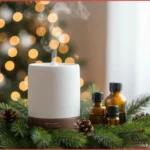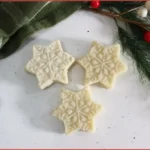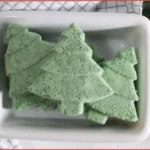The terms essential oil and fragrance oil are often used interchangeably but that’s incorrect. There are several important differences between essential oils and fragrance oils.
While both oils are used to add scents to various products, they differ considerably in their composition and production methods.
Here’s a detailed look at the comparison of essential oils vs. fragrance oils and how to determine the difference between the two when buying.
Table of Contents
Affiliate Disclosure: Some links on this site are affiliate links. I may earn a small commission if you purchase through them, at no extra cost to you. See the full affiliate disclosure.
Essential Oils vs. Fragrance Oils: Definition

✨ Get 12 Free Holiday Diffuser Blends — Printable PDF
Instantly make your home smell like Christmas with these festive, ready-to-use recipes.
Essential Oils
Essential oils are natural extracts derived from plant material, such as flowers, leaves, bark, or seeds. They are extracted through processes like steam distillation or cold-pressing.
Fragrance Oils
Fragrance oils, also known as synthetic or aroma oils, are artificially created scents. They are typically made from a combination of synthetic chemicals and natural aromatic compounds.
Essential Oils vs. Fragrance Oils: Composition
Essential Oils
Essential oils are highly concentrated and contain the natural aromatic compounds found in plants. They retain the characteristic scent and therapeutic properties of the plant they are derived from.
The complex composition of each essential oil makes it difficult to replicate the oil synthetically in a laboratory. This is because the chemical components can vary in the same plant species according to the season, climatic conditions, and growing conditions.
Fragrance Oils
Fragrance oils are designed to mimic the scent of various natural substances, such as flowers, fruits, or spices. They are formulated in laboratories to achieve specific smells and do not necessarily contain any natural ingredients.
They contain a combination of synthetic chemicals and natural aromatic compounds designed to mimic the scent of various natural substances, such as flowers, fruits, or spices.
Because fragrance oils are made synthetically, it is easy to identify every component in the oil. This means every fragrance oil can be easily replicated to possess the exact same aromas and they can just as easily be altered to create an endless variety of new aromas.
Essential Oils vs. Fragrance Oils: Source & Production

Essential Oils
Essential oils are obtained directly from plant parts.
They can be extracted from a wide range of botanical sources, including herbs, trees, and citrus fruits using processes such as steam distillation, cold-pressing, and solvent extraction to produce essential oils.
For example, lavender essential oil is extracted by steam distilling lavender flowers, while lemon essential oil is extracted by cold-compression of the fruit rind.
The extraction methods preserve the volatile compounds responsible for the aromatic properties of the plant.
Fragrance Oils
Fragrance oils are created through synthetic means in a laboratory.
They are formulated by chemists using a combination of artificial aromatic compounds, natural extracts, and other synthetic ingredients.
Fragrance oils allow for more consistency in scent as they can be replicated precisely, unlike essential oils that can vary in aroma due to factors like plant species, climate, and extraction method.
Essential Oils vs. Fragrance Oils: Aroma

Essential Oils
Essential oils offer the true aroma of the plant they are derived from. They provide a natural and complex scent profile that can vary depending on the plant species, growing conditions, and extraction process.
Essential oils often have therapeutic properties and are commonly used in aromatherapy due to their potential health benefits.
Fragrance Oils
Fragrance oils are created to mimic specific scents, and their aroma is not necessarily derived from natural sources. They can be formulated to imitate the scent of flowers, fruits, food items, or other substances.
Fragrance oils offer a wide range of scents that may not be found in nature, making them versatile for various applications in perfumery and product manufacturing.
Essential Oils vs. Fragrance Oils: Uses
Essential Oils
Essential oils have been used for centuries in a variety of applications. They are commonly used in aromatherapy, skin care products, massage oils, natural cleaning products, and as flavorings in food and beverages.
They are valued for their potential therapeutic properties from relaxation and mood enhancement, to boosting wellness.
Fragrance Oils
Fragrance oils are widely used in the fragrance industry for products like perfumes, colognes, body lotions, candles, soaps, and air fresheners.
They provide a consistent and long-lasting scent that can be customized to suit specific preferences. Fragrance oils are primarily used for their aromatic qualities rather than their potential therapeutic benefits.
Essential Oils vs. Fragrance Oils: Allergies and Sensitivities
Essential Oils
It is generally safe to inhale essential oils or use them for topical applications provided you follow all safety guidelines.
When you use essential oils as recommended, there’s little to no risk of experiencing any adverse reaction.
However, if you are allergic or sensitive to certain plants or plant families, it’s best to avoid oils extracted from those plants.
If you’re using an essential oil for the first time, it’s advisable to perform a patch test before applying it to the skin.
Fragrance Oils
Fragrance oils are more likely to cause allergies or sensitivities. This is because they often contain potentially irritating ingredients that can irritate the lungs when inhaled
It’s best to avoid skincare products that are scented with fragrance oils as these may cause skin irritation. This is especially important if you have sensitive skin.
Take time to read product labels and consider personal sensitivities when shopping for oils to scent your homemade body and bath care products.
Essential Oils vs. Fragrance Oils: How to Spot The Differences

Consider these 6 factors to determine whether you’re buying an essential oil or a fragrance oil. Reading this ultimate guide to buying essential oils will also guide you toward making the right purchase.
1. Terminology Used on the Label
When purchasing oils, carefully read the product label. Look for terms like “100% pure essential oil” or “natural essential oil” to ensure you are buying an essential oil. If the label mentions “fragrance oil,” “perfume oil,” or “aroma oil,” it indicates that you are purchasing a synthetic or blended fragrance oil.
2. Ingredient List
Examine the ingredient list provided on the packaging or product description. Essential oils should list the specific botanical source from which they are derived. For fragrance oils, the ingredient list might include synthetic compounds or generic terms such as “fragrance blend” or “aromatic compounds.”
3. Price
Generally, essential oils tend to be more expensive than fragrance oils due to the cost of extracting and processing natural plant materials. If a product is significantly cheaper than other similar offerings, it may be an indication that it contains fragrance oils rather than essential oils.
4. Packaging & Brand Reputation
Reputable essential oil brands often provide detailed information about sourcing and extraction methods, and the purity of their products. Look for brands that prioritize transparency, and provide specific certifications, such as “Therapeutic Grade” or “Certified Organic.”
Fragrance oils, on the other hand, may have less emphasis on plant origins and focus more on the scent itself.
5. Testing & Certification
Essential oil suppliers may provide third-party testing results or certifications to verify the authenticity and quality of their oils. Look for certifications from organizations such as the International Organization for Standardization (ISO) or the National Association for Holistic Aromatherapy (NAHA). Such certifications ensure that the oil has been tested for purity and meets specific quality standards.
6. Scent Variations
Essential oils derived from natural sources can have slight variations in aroma due to factors like plant species, geographic location, and extraction method. If a product consistently offers the identical scent across different batches or claims to have an extensive range of unique fragrances, it is likely a fragrance oil.
Remember that the intended use and personal preference should guide your choice between essential oils vs. fragrance oils.
If you’re looking for the therapeutic benefits of plants or prefer natural scents, essential oils are a better option. On the other hand, if you prioritize consistent and diverse scents or require oils for fragrance applications, fragrance oils may be more suitable.
You may also be interested in learning about the difference between infused oils and essential oils.




